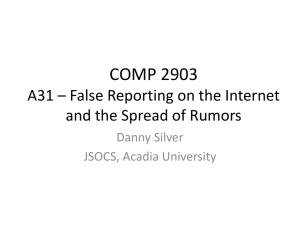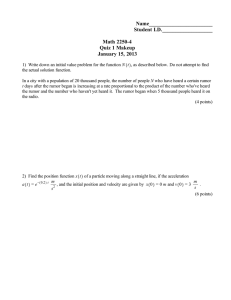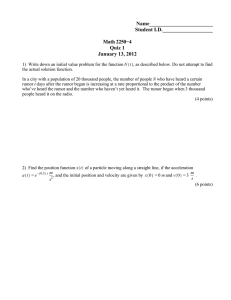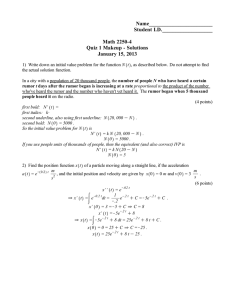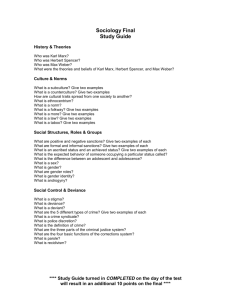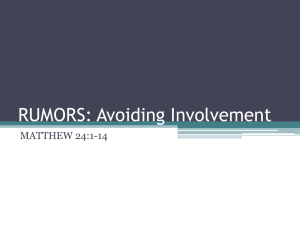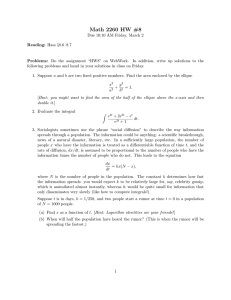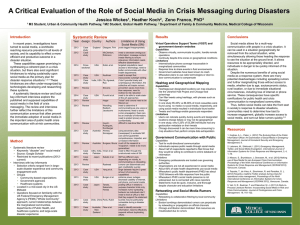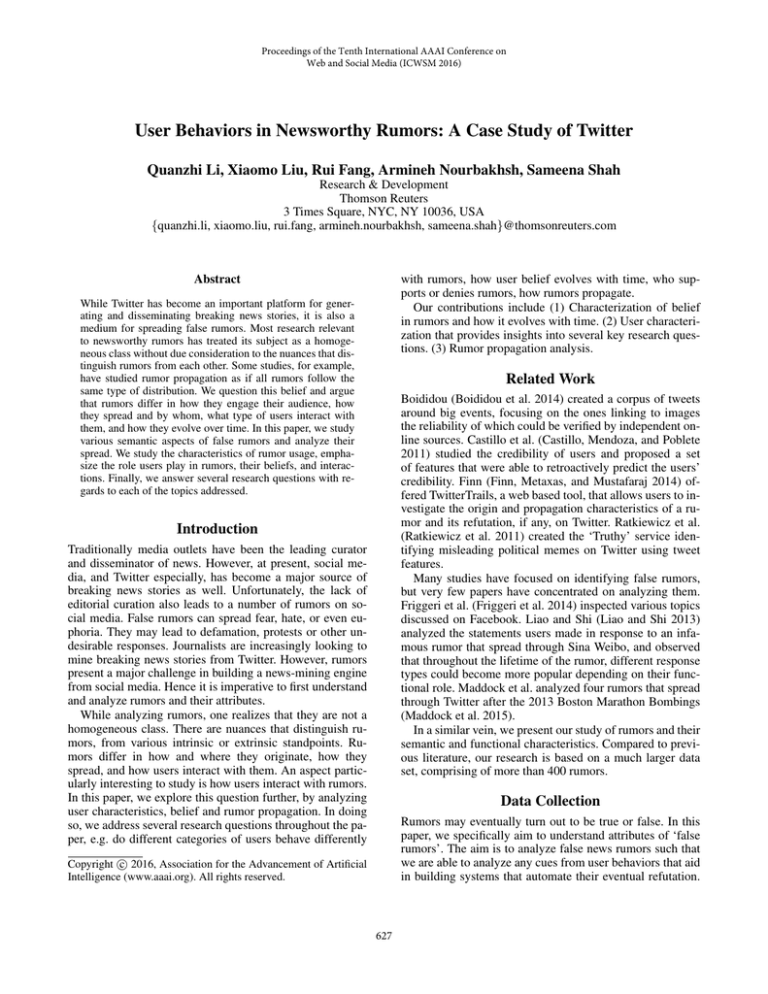
Proceedings of the Tenth International AAAI Conference on
Web and Social Media (ICWSM 2016)
User Behaviors in Newsworthy Rumors: A Case Study of Twitter
Quanzhi Li, Xiaomo Liu, Rui Fang, Armineh Nourbakhsh, Sameena Shah
Research & Development
Thomson Reuters
3 Times Square, NYC, NY 10036, USA
{quanzhi.li, xiaomo.liu, rui.fang, armineh.nourbakhsh, sameena.shah}@thomsonreuters.com
with rumors, how user belief evolves with time, who supports or denies rumors, how rumors propagate.
Our contributions include (1) Characterization of belief
in rumors and how it evolves with time. (2) User characterization that provides insights into several key research questions. (3) Rumor propagation analysis.
Abstract
While Twitter has become an important platform for generating and disseminating breaking news stories, it is also a
medium for spreading false rumors. Most research relevant
to newsworthy rumors has treated its subject as a homogeneous class without due consideration to the nuances that distinguish rumors from each other. Some studies, for example,
have studied rumor propagation as if all rumors follow the
same type of distribution. We question this belief and argue
that rumors differ in how they engage their audience, how
they spread and by whom, what type of users interact with
them, and how they evolve over time. In this paper, we study
various semantic aspects of false rumors and analyze their
spread. We study the characteristics of rumor usage, emphasize the role users play in rumors, their beliefs, and interactions. Finally, we answer several research questions with regards to each of the topics addressed.
Related Work
Boididou (Boididou et al. 2014) created a corpus of tweets
around big events, focusing on the ones linking to images
the reliability of which could be verified by independent online sources. Castillo et al. (Castillo, Mendoza, and Poblete
2011) studied the credibility of users and proposed a set
of features that were able to retroactively predict the users’
credibility. Finn (Finn, Metaxas, and Mustafaraj 2014) offered TwitterTrails, a web based tool, that allows users to investigate the origin and propagation characteristics of a rumor and its refutation, if any, on Twitter. Ratkiewicz et al.
(Ratkiewicz et al. 2011) created the ‘Truthy’ service identifying misleading political memes on Twitter using tweet
features.
Many studies have focused on identifying false rumors,
but very few papers have concentrated on analyzing them.
Friggeri et al. (Friggeri et al. 2014) inspected various topics
discussed on Facebook. Liao and Shi (Liao and Shi 2013)
analyzed the statements users made in response to an infamous rumor that spread through Sina Weibo, and observed
that throughout the lifetime of the rumor, different response
types could become more popular depending on their functional role. Maddock et al. analyzed four rumors that spread
through Twitter after the 2013 Boston Marathon Bombings
(Maddock et al. 2015).
In a similar vein, we present our study of rumors and their
semantic and functional characteristics. Compared to previous literature, our research is based on a much larger data
set, comprising of more than 400 rumors.
Introduction
Traditionally media outlets have been the leading curator
and disseminator of news. However, at present, social media, and Twitter especially, has become a major source of
breaking news stories as well. Unfortunately, the lack of
editorial curation also leads to a number of rumors on social media. False rumors can spread fear, hate, or even euphoria. They may lead to defamation, protests or other undesirable responses. Journalists are increasingly looking to
mine breaking news stories from Twitter. However, rumors
present a major challenge in building a news-mining engine
from social media. Hence it is imperative to first understand
and analyze rumors and their attributes.
While analyzing rumors, one realizes that they are not a
homogeneous class. There are nuances that distinguish rumors, from various intrinsic or extrinsic standpoints. Rumors differ in how and where they originate, how they
spread, and how users interact with them. An aspect particularly interesting to study is how users interact with rumors.
In this paper, we explore this question further, by analyzing
user characteristics, belief and rumor propagation. In doing
so, we address several research questions throughout the paper, e.g. do different categories of users behave differently
Data Collection
Rumors may eventually turn out to be true or false. In this
paper, we specifically aim to understand attributes of ‘false
rumors’. The aim is to analyze false news rumors such that
we are able to analyze any cues from user behaviors that aid
in building systems that automate their eventual refutation.
c 2016, Association for the Advancement of Artificial
Copyright Intelligence (www.aaai.org). All rights reserved.
627
0.30
Note that many rumors that originate on social media die
out before being noticed by anyone outside of the immediate
clique of users who are exposed to them. We consider these
rumors not “newsworthy” enough to spread on social media,
and ignore them in our study. So, in this study, we consider
two dedicated services that identify rumors on social media,
namely Snopes.com and Emergent.info. Detailed introduction about these two sites, and how we collected the false
stories and their related tweets are described in our previous
study (Nourbakhsh et al. 2015).
Our final data set contained 421 false stories, and all of
the associated tweets with each story. The average number of
tweets for each rumor was 906. The number of tweets varied
greatly by rumor, with a maximum of 11,064 and minimum
of just 11. The total number of tweets in this data set was
about 1.47 million.
0.20
0.15
0.05
0.10
percentage
0.25
denial
question
support
10min
1hour
4hour
1day
3day
5day
7day
9day
time eclipse
Figure 1: User belief distribution and evolution over time
Understanding User Beliefs to Rumor
We define belief as a user’s response to the rumor, that is,
whether they express their belief or disbelief towards the
subject. Identifying belief in rumors can help reveal many
semantic aspects of their origination and propagation, for instance, what types of users are likelier to believe a rumor, or
be more skeptical.
We characterize belief in either of the four categories Support, Deny, Question and Neutral. We classify a Twitter user
in either category based on the language and message analysis of his/her tweet text. The user in the ‘support’ tweet
believes the rumor, while the users in the ‘deny’ and ‘question’ express denial or doubt. The user in the ‘neutral’ category doesn’t make an explicit statement about their belief.
In order to extract belief from each tweet, we implemented
a rule-based approach. The rules were constructed manually
and were based on insights derived from the data. The rules
were driven off a list of 11 positive words, 73 negative words
and 8 negation words.
We partitioned tweets based on the delay between the associated rumor’s origination time and their own timestamp
into different time intervals. For example, the first 10 minutes after the rumor was posted, 10 minutes to 30 minutes,
30 minutes to 1 hour, etc. We calculated the percentage of
users in each belief category for each time interval. Finally,
we averaged the percentages over the entire corpus of rumors. Figure 1 shows the percentage of users’ belief over
the rumors and their evolution over time1 .
Do people believe rumors? As the figure shows, the
overall percentage of tweets that express any belief category
is low. Most users disseminate information without expressing a particular belief about the topic. This might be a result
of Twitter’s character limit which doesn’t always leave room
for discussion or reflection on the messages.
Does belief evolve with time? Figure 1 highlights the fact
that in the first half hour of the birth of a rumor, the percentage of tweets that deny or question the event are less than the
percentage of tweets that support the rumor. We suspect that
this is the result of the lack of evidence to deny the rumor,
or possibly a clique of users who intentionally promote the
rumor. After about half an hour of the rumor origination, as
more evidence is collected and brought to light, the percentage of tweets that deny the rumor continues to grow larger
than the support tweets. After a few days lapse, the percentages of support, denial and question tend to go down. We
hypothesize that this is due to dwindling interest from users,
and lack of any new information.
Multi-Level User Categorization
In this section, we study if there are any specific qualities
that one can ascribe to users involved in rumor conversations.
User Types and Their Beliefs
We hypothesize that one can distinguish users across four
dimensions. Each dimension is boolean in nature with only
two categories, Yes (Y) and No (Y). Table 1 lists these four
dimensions. For computing the News Organization dimension, we built a list of the Twitter handles of some of the
most credible and popular local and global news organizations, such as CNN and Reuters. There are a total of 2,040
news handles on our list.
For the Highly Visible dimension, similar to other studies
(Liao and Shi 2013; Castillo, Mendoza, and Poblete 2011),
we classified users by applying a threshold based on the
number of followers. One assumes that if a highly visible
account posts a message it will be seen by a large number of
users. While high visibility may be related to high credibility, low visibility is not a proxy for low credibility. Hence,
we explicitly model credibility as a fourth dimension. The
motivation is to analyze if users with lower credibility act
differently from ordinary users. The user credibility algorithm (Castillo, Mendoza, and Poblete 2011) considers several factors like account age, number of tweets posted, if the
profile has a description, image or link, etc.
Table 2 presents, for each user category dimension, the
distribution within the four Belief categories. Note that the
1
The ‘neutral‘ category always has the dominant number of
tweets in each time interval, in order to see the trends in the other
three categories more clearly, we do not show the trend for neutral
category.
628
Table 1: User categorization.
User Category
Dimension
Verified
News Org.
Highly Visible
Low Credibility
Table 3: User distribution comparison (support vs. denial +
question).
Value
Description
Y
N
Y
N
Y
N
Y
N
Account is verified
Account is not verified
News organization account
Non-news organization account
No. of followers >= 5,000
No. of followers <5,000
Account with low credibility
Account with high credibility
User Category
Dimension
Verified
News Org.
Highly Visible
Low Credibility
Table 2: User distribution over tweet belief categories and
user categories.
User Category
Dimension
Y
Verified
N
News
Y
Org.
N
Highly
Y
Visible
N
Low
Y
Cred.
N
% Users in Belief Category
Support
Neutral
Deny
1.41
63.47
18.21
32.86
12.18
27.26
1.76
75.13
10.05
32.75
8.29
29.98
1.48
70.63
16.27
32.84
9.79
27.91
1.88
73.74
14.72
32.71
8.75
28.43
Question
16.92
27.69
13.07
28.98
11.62
29.46
9.67
30.11
Y
N
Y
N
Y
N
Y
N
% Users in Tweet Belief
Category
Deny +Question
Support
35.13
1.41
54.96
32.86
23.12
1.76
58.96
32.75
27.89
1.48
57.37
32.84
24.38
1.88
58.54
32.71
Ratio of
(D+Q)/S
25.00
1.67
40.00
1.8
18.84
1.75
12.96
1.79
degree, the Question category is close to the Deny category.
Hence, in determining the stringency of different user types
with regards to supporting or denying/questioning a rumor,
we group the Deny and Question categories together. In Table 3, we compare the combined categories with the Support
category.
The values in the Deny+Question column are the combination of Deny and Question columns in Table 2. The
last column of this table shows the ratio of Deny+Question
values to Support values. It reflects how big the difference
is between these two values. The bigger the ratio is, the
larger the portion of users denying or questioning the rumor
than supporting it. From this table, we see that for Verified
users, there are 25 times more users in Deny or Question
categories than in Support category. In contrast, for nonverified users, this ratio is just 1.67 times. We can observe
similar behavior in News Organizations, with a ratio of 40
vs. 1.8. This shows that, in terms of supporting or debunking/questioning a rumor, verified users and news organizations are much more stringent, and hence a more trustworthy source than their corresponding counterparts. For Highly
Visible and Low Credibility dimensions, the difference between the two ratios is not as big. This indicates that highly
visible accounts, that is, accounts with a large number of followers, can sometimes be as untrustworthy as accounts with
a low level of credibility.
Share of
all Users
0.34
99.66
0.03
99.97
2.77
97.23
3.04
96.96
values are percentages of users which are averaged over 421
rumors. The reason for using percentages, instead of counts,
is that the number of tweets for each rumor has a large variance. Examining Table 2 reveals several findings:
Do News organizations, and other credible sources
spread rumors? We find that news organizations, verified
users and influential users do spread rumors. This is reflected
by the percentages in the Neutral and Support columns.
While they rarely explicitly support the claims in the rumors,
they do spread the rumors by either re-tweeting them, or expressing a neutral opinion in a tweet.
Do different user types demonstrate different beliefs?:
For any category in any of the four user dimensions, Neutral
has the largest user percentage amongst the four Belief categories. This is true for both news organizations and verified
users. This conforms to rumor theory (Buckner 1965), which
states that when people do not have clarity about the veracity
of a rumor, they usually just spread it without adding their
opinions due to lack of evidence.
Where does support for rumors come from?: Compared to the other three Belief categories, the Support category has the smallest portion of users, irrespective of user
category. This finding is consistent with the intuition that
people are reluctant to support a claim when they do not
have enough evidence. We also find that news organizations
provide the smallest proportion of support (0.0176 * 0.003
= .005%), while low credibility accounts provide the most
support (0.0188 * 0.0304 =0.06%), but the margins are very
small.
Who denies rumors? The highest proportion of denials
comes from verified users (0.1821 * 0.034 = 6%) while the
least comes from users with low credibility.
Which user-type is most skeptical in accepting rumors? Questioning a rumor usually implies doubts about
the rumor or claim. This usually happens when the user does
not have direct evidence to support or deny a rumor, but still
doubts it, based on his or her knowledge or experience. To a
Characterizing Users in Rumor Propagation
In this section, we examine the characteristics of users
during the rumor propagation on Twitter. Our study analyzed which parts of a rumor’s evolution did particular
account-types pick up on. We defined four types of accounts that were of interest: (1) rumor tackers - snopes.com
and emergent.info. Since our dataset was collected using
these two trackers, their tweet handles were very likely to
appear in each rumor in our dataset; (2) verified users - as
previously discussed, these users can be more believable to
people and are thus important sources of dissemination of information and misinformation; (3) news organizations - the
account names were checked against a list of news organizations to ensure accuracy; (4) the most re-tweeted tweet in
each rumor was also included in the analysis.
We compared the first appearance of a tweet from each
of the above-mentioned accounts and the corresponding rumor’s trending period. The official trend detection algorithm in Twitter is never disclosed publicly. Mathioudakis
629
200
In this paper, we developed a framework to characterize false
rumors. Using a set of 421 distinct rumors, we organized the
study around capturing various semantic aspects of rumors.
We proposed a methodology to characterize Belief and captured how it evolves with time. We characterized rumor usage and determined the roles various user-types play, and
how they vary with respect to Beliefs. We used the framework to answer several research questions. Ultimately, our
characterization covers usage analysis of rumors and aids in
creating systems that uncover news from Twitter by eliminating rumors automatically.
−100
Hours
500
Conclusion
rumor trackers
50
100
200
250
0
10
20
400
0
30
40
50
0
verified
−400
Hours
150
news
−200
Hours
0
100
400
50
150
200
250
References
300
Boididou, C.; Papadopoulos, S.; Kompatsiaris, Y.; Schifferes, S.; and Newman, N. 2014. Challenges of computational verification in social multimedia. In Proc. of the 23rd
International Conference on World Wide Web Companion,
743–748.
Buckner, H. T. 1965. A theory of rumor transmission. In
Public Opinion Quarterly, 54–70.
Castillo, C.; Mendoza, M.; and Poblete, B. 2011. Information credibility on twitter. In WWW, 675–684.
Finn, S.; Metaxas, P. T.; and Mustafaraj, E. 2014. Investigating rumor propagation with twittertrails. arXiv:1411.3550.
Friggeri, A.; Adamic, L. A.; Eckles, D.; and Cheng, J. 2014.
Rumor cascades. In Proc. of the Eighth International AAAI
Conference on Weblogs and Social Media.
Kleinberg, J. 2003. Bursty and hierarchical structure in
streams. Data Mining and Knowledge Discovery 7(4):373–
397.
Liao, Q., and Shi, L. 2013. She gets a sports car from our donation: rumor transmission in a chinese microblogging community. In Proceedings of the 2013 Conference on Computer
Supported Cooperative Work, 587–598. ACM.
Maddock, J.; Starbird, K.; Al-Hassani, H. J.; Sandoval,
D. E.; Orand, M.; and Mason, R. M. 2015. Characterizing online rumoring behavior using multi-dimensional signatures. In Proceedings of the 18th ACM Conference on
Computer Supported Cooperative Work, 228–241. ACM.
Mathioudakis, M., and Koudas, N. 2010. Twittermonitor:
trend detection over the twitter stream. In Proc. of the 2010
ACM SIGMOD International Conference on Management of
Data, 1155–1158. ACM.
Nourbakhsh, A.; Liu, X.; Shah, S.; Fang, R.; Ghassemi,
M. M.; and Li, Q. 2015. Newsworthy rumor events: A case
study of twitter. In Proceedings of 2015 IEEE International
Conference on Data Mining Workshop, 27–32. IEEE.
Ratkiewicz, J.; Conover, M.; Meiss, M.; Gonçalves, B.;
Flammini, A.; and Menczer, F. 2011. Detecting and tracking political abuse in social media. In The Fifth International
AAAI Conference on Weblogs and Social Media.
Wu, K.; Yang, S.; and Zhu, K. Q. 2015. False rumors detection on sina weibo by propagation structures. In IEEE
International Conference of Data Engineering.
most retweeted
−200 100
Hours
0
0
50
100
150
200
250
300
350
Figure 2: Time difference (in hours) between each rumor’s
burst period and the first appearance of rumor trackers, news
agencies, verified users and most re-tweeted tweets. Time
difference is negative, zero or positive if tweets are before,
during or after the burst.
and Koudas pioneered the idea of detecting trends through
the bursts from the dynamics of tweet frequencies (Mathioudakis and Koudas 2010). Similarly, we used Kleinberg’s
burst detection algorithm to identify the main burst-period
of each rumor 2 (Kleinberg 2003). The burst period was represented as an interval [t0 , t1 ]. We then compute the relative
time between the tweet being posted and the time that the
rumor beings trending (burst). For each tweet with timestamp t, the burst metric was calculated as t - t0 if the tweet
was posted before t0 , and as t - t1 , if the tweet was posted
after t1 . If a tweet was posted during a burst period, its burst
metric was set to 0.
Figure 2 shows the results3 . As the figure shows, only a
small portion of tweets from the four account-types were
published before the burst period, i.e. before the rumors
came to wide public attention. This is intuitive, because if
a rumor doesn’t have any visibility, rumor trackers and news
media will often not bother to report or debunk it. However,
in order to relieve public anxiety and minimize misinformation on social media, it is ideal to have a method to debunk
rumors even before they begin trending. This indicates the
need for new machine learning algorithms that can predict
rumors in early stages, as in (Wu, Yang, and Zhu 2015).
2
This algorithm can detect multiple bursts from one set of
tweets. We only take the burst that includes the highest peak.
3
As you can observe, the baseline for each account-type differs.
This is because some account-types did not appear in some rumors
in our dataset. For instance, not all rumors included tweets from
verified users
630

